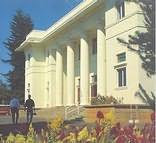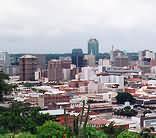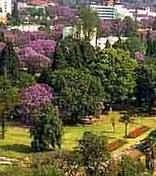The capital city of Zimbabwe, Harare, is a beautiful, light-filled, open city; high on the country's central plateaux.
It is a city of modern buildings, wide thoroughfares, numerous parks and gardens. A city whose streets are lined with flowering trees and a wonderful and invigorating climate.
There is a strong appreciation for the city's cultural and historical heritage and a number of the older buildings have been preserved. The Mining Pension Fund Building at Central Avenue and Second Street is one example and many more are to be found along Robert Mugabe Road between Second Street and Julius Nyerere Way.
The National Gallery houses not only a valuable and interesting national collection but also hosts travelling international exhibitions and has a permanent display of some outstanding Shona soft-stone carvings.
The priceless collection of Rhodesiana and Africana in the form of diaries, notebooks and reports of various origins, are housed in the National Archives. Some of the original works of some of the greatest names in African exploration and missionary can be viewed.
Other institutions which are well worth visiting include the Queen Victoria Museum and the Queen Victoria National Library, both at the Civic Centre; in Rotten Row.
The city was laid out with large open spaces like the 68ha National Botanic Garden with more than 900 species of wild trees and shrubs from all over the country. The Mukuvisi Woodlands
is 277 hectares of remarkably preserved natural woodland that stances astride the banks of the small Mukuvisi stream. A variety of bird and of wild animal species such as giraffe, zebra, impala, tsessche, wildebeest, bushbuck, steenbuck, reed buck and eland can be viewed.
If you want to experience shopping the way it is traditionally done in many African countries, you need to stroll around at the open flea-market at Mbare. Here tourists can feast their eyes on a colourful array of baskets, food, clothing and other items.
The Kopje, a granite hill rising above the south-west corner of central Harare, is a great place to go for views of the city.
Bulawayo
Bulawayo is Zimbabwe's second largest city. Located in the South-west of the country, it is home to more than a million people. Bulawayo is the hub of the province of Matabeleland which comprises the whole western Zimbabwe from the South African border in the south to Victoria Falls in the north.
The city has wide tree lined streets and is surrounded by beautifull parks, a legacy of Cecil John Rhodes. Within the city are many examples of early Victorian buildings which are maintained by the Bulawayo City council and landlords as heritage sites.
Bulawayo houses the country's main museum, the natural history museum, a railway museum, the Bulawayo Art gallery, which is housed in a most attractive turn of the century building, theatres, the Mzilikmzi Art and craft centre, good hotels and one of the finest caravan and camping parks in Zimbabawe. Bulawayo is also home to the Chipangali wildlife orphanage and the Kame Ruins.
One of Zimbabawe's major tourist attractions is the Matopas National Park, less than an hour's drive from the city. As one leaves the city travelling south, many granite outcrops are seen. They increase in number and size as the distance from the city grows. By the time the Park is entered one is surrounded by a dramatic and enveloping scenery that is unique and extraordinary.
Just twenty-two kilometers to the west of the Bulawayo is Kame Ruins, one of southern Africa's magnificent Late Iron Age ruins (now an Unesco World heritage Site.) The land adjoining the ruins has been made into a Nature Reserve by the City Council, called Mazwi Nature Reserve, where the visitor may walk, drive and picnic.
Also worth a visit and situated on the main Gwanda Road, 23km from Bulawayo is the Chipangali Wildlife Orphanage and Research Centre, a home for orphaned, sick or abandoned wild animals. There are lion, leopard, cheetah, black rhino; many species of antelope and a large colletion of birds.
Mzilikazi Arts and Crafts Centre, situated just out of town off the Old Falls road, is definitely worth a visit where visitors can choose from a wide selection of skilfully crafted sculptures, basketry, pottery, beadwork and woodwork - all done by local people.
Chitungwiza
Chitungwiza South is a parliamentary constituency in the city-province of Harare in Zimbabwe. It covers a part of Chitungwiza, which is a suburb of Harare and the second largest city in the country in terms of population.
| |
|

|




0 comments:
Post a Comment